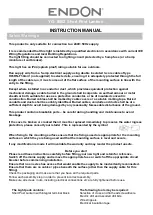
1
REMOTE LIGHT INSTALLATION
MODEL 041A6287
INTRODUCTION
The remote light (garage door opener light) is designed to plug directly
into a standard 120V outlet. Select an appropriate location on the ceiling
to mount the light within 6 feet (1.83 m) of an electrical outlet so that the
cord and light are away from moving parts.
To reduce the risk of SEVERE INJURY or DEATH:
• This portable luminaire has a polarized plug (one blade is wider
than the other) as a feature to reduce the risk of electric shock.
• This plug will fit in a polarized outlet ONLY one way.
• If the plug does not fit fully in the outlet, reverse the plug.
• If it still does not fit, contact a qualified electrician.
• NEVER use with an extension cord unless plug can be fully
inserted.
• DO NOT alter the plug.
• Light is intended for ceiling mount and indoor applications ONLY.
WARNING:
This product can expose you to chemicals
including lead, which are known to the State of California to
cause cancer or birth defects or other reproductive harm. For
more information go to
www.P65Warnings.ca.gov
To prevent possible OVERHEATING of the endpanel or light socket:
• DO NOT use short neck or specialty light bulbs.
• DO NOT use halogen bulbs. Use ONLY incandescent.
• DO NOT use bulbs larger than 100W.
• ONLY use A19 size bulbs.
To provide an adequate visual alert, the garage door opener light bulb
MUST be a minimum of 40 Watt (or equivalent).
PROGRAMMING
1. Press the "learn button" on light until LED
comes ON.
2. Activate the garage door using the handheld
remote, wall control or keyless entry.
3. It has learned the code and the light turns on.
Latch Clip
Light Clip
Screw
Screws
Light Lens
Wall Anchor
Cord
Retainer
100 Watt
(max.)
Metal
Plate
Plastic
Housing
Hinge Clip
Drywall Anchor (screw-in) (2)
HARDWARE
Screw #4-20x7/16" (2)
Screw #6x1" (2)
Light Base
Antenna needs to be
fully exposed to prevent
intermittent light
behavior.
INSTALLATION
1. Install the hinge and latch clips. Clips slide in between the metal plate
and the plastic housing on each side of the light base. Secure the
clips to the light base using the #4-20 x 7/16" screws.
2. Install the mounting plate with the screws provided. Leave 1/8" (3
mm) of the thread exposed between the ceiling and the screw head.
NOTE:
If installing light on drywall and a ceiling joist cannot be
located, use drywall anchors provided. No pilot hole is required for
drywall anchors.
3. Determine the length of power cord needed to reach the nearest
outlet. Wind any excess cord around cord retainer on the top side of
the light base.
4. Install the light base by pushing onto the screws and turning the base
clockwise to lock the light in place.
5. Install two Type A19 incandescent or compact fluorescent bulbs (100
watt maximum per bulb, 200 watts total).
NOTE:
Do not use LED
bulbs as they may reduce the range or performance of your remote
control(s).
6. Install the light lens by hooking one end of the lens over the hinge
and pressing up on the other end to latch into place.
7. Plug in the light to outlet.
NOTE:
Light will not operate until the garage door opener is
activated. Multiple operators in the same garage may cause
interference between lights. Program all lights to one operator to
avoid interference.
NOTICE:
This device complies with Part 15 of the FCC rules and Industry Canada’s license-exempt RSSs. Operation is subject
to the following two conditions: (1) this device may not cause harmful interference, and (2) this device must accept any
interference received, including interference that may cause undesired operation.
Any changes or modifications not expressly approved by the party responsible for compliance could void the user’s authority
to operate the equipment.
This device must be installed to ensure a minimum 20 cm (8 in.) distance is maintained between users/bystanders and device.
This device has been tested and found to comply with the limits for a Class B digital device, pursuant to part 15 of the FCC rules
and Industry Canada ICES standard. These limits are designed to provide reasonable protection against harmful interference in
a residential installation. This equipment generates, uses and can radiate radio frequency energy and, if not installed and used
in accordance with the instructions, may cause harmful interference to radio communications. However, there is no guarantee
that interference will not occur in a particular installation. If this equipment does cause harmful interference to radio or
television reception, which can be determined by turning the equipment off and on, the user is encouraged to try to correct the
interference by one or more of the following measures:
• Reorient or relocate the receiving antenna.
• Increase the separation between the equipment and receiver.
• Connect the equipment into an outlet on a circuit different from that to which the receiver is connected.
• Consult the dealer or an experienced radio/TV technician for help.






















